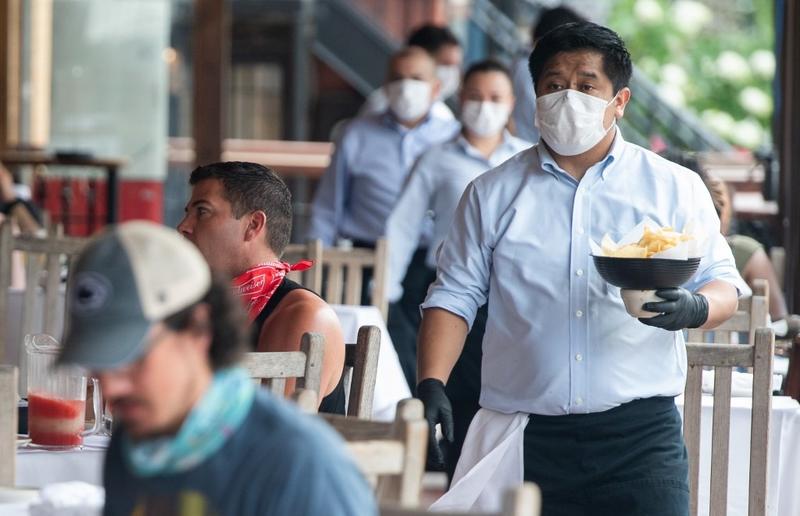 A waiter wearing a mask and gloves delivers food to a table to customers seated at an outdoor patio at a Mexican restaurant in Washington, DC, May 29, 2020. (SAUL LOEB / AFP)
A waiter wearing a mask and gloves delivers food to a table to customers seated at an outdoor patio at a Mexican restaurant in Washington, DC, May 29, 2020. (SAUL LOEB / AFP)
Restaurants in the United States lost US$120 billion due to the novel coronavirus pandemic and they will face significant challenges to fully recover as states reopen, say industry experts.
The losses detailed in a report by the National Restaurant Association-a business association representing 380,000 restaurants-lays bare just how detrimental COVID-19 has been and how much the sector must change
The losses detailed in a report by the National Restaurant Association-a business association representing 380,000 restaurants-lays bare just how detrimental COVID-19 has been and how much the sector must change.
"Restaurants must keep patrons and staff safe. To do so, all will need proper personal protective equipment and additional cleaning supplies and procedures to ensure increased sanitation," said Melissa Fleischut, president and CEO of the New York State Restaurant Association.
She said that restaurants will have to deal with social distancing requirements and 50 percent capacity limits that will make profitability a challenge.
"On top of that, a vast majority of restaurants have had to lay off or furlough employees during the pandemic, so many will have to hire more staff," Fleischut said. "Lastly, rent payments, which have been piling up for some restaurants, are a constant concern for those based in New York City and represent a sizable amount of operating expenses."
In New York, once the epicenter of the US virus, dine-in restaurants were forced to close their doors from mid-March to stop the spread of COVID-19. This led to a 58 percent drop in sales compared with the same period in 2019, according to the National Restaurant Association.
ALSO READ: US schools canceling security contracts
While eateries in New York were allowed to do takeout, delivery, and curbside pick-ups during the pandemic, they still lost US$2 billion during the lockdown, the restaurant association said. Owners in the city were also forced to lay off 250,000 of its 350,000 workers, its figures show.
Toby Cecchini, co-owner of two bars in Brooklyn, wrote in an opinion piece for The New York Times:"I have worked in the restaurant industry for 41 years, as a server, a bartender and, for the past 22 years, an owner. We have weathered upheavals, 9/11, the downturn of 2008 and Hurricane Sandy. But the food and beverage service industry has been hit harder than almost any other in this pandemic, accounting for 60 percent of the jobs lost in March."
Crucial phase three
New York City entered phase one of its reopening plan on June 8. Phase two, scheduled for June 22, will allow restaurants to have customers dine outside.
The city also plans to enable restaurants to expand curbside seating space by using parking spaces. Phase three, planned for July, will allow eating and drinking inside restaurants, a crucial step, say experts.
Big fast-food chains also face a tough road ahead, according to a report by S&P Global. It found the likelihood that some of the country's largest publicly traded companies could default has gone up. To default means that they will not be able to pay debts within the next year based on fluctuations in the company's share price due to a lack of business.
READ MORE: Virus: US cases rise at two-week high
But McDonald's Corp and Yum Brands Inc's Taco Bell, which rely on franchisees that allow them to collect royalties from independent operators, have a better outlook.
McDonald's odds of defaulting within the next year as of May 18 were 8.4 percent, while Yum Brands had a 14.8 percent chance of defaulting, according to Market Intelligence.


